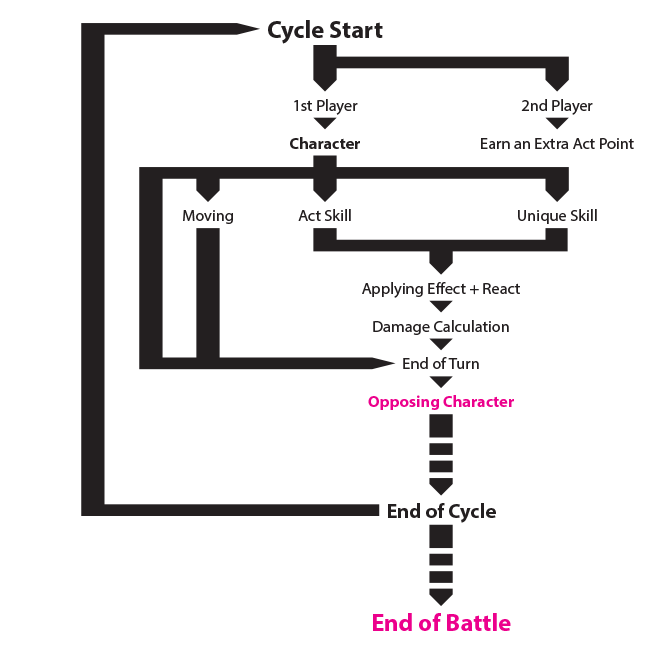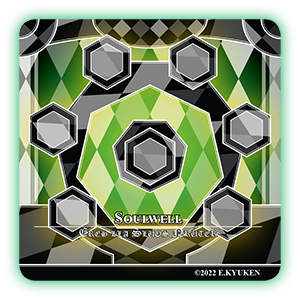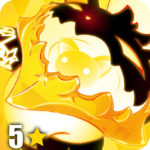
is an original turn-based strategy cardgame in the universe of Why the Lust doesn't wear Panties ?
Each player builds an army of Heroes and Units to go to War.
In the End, only one army will remain and victory will only be achieved by defeating the oppposing Force.
Game Rules
Character Cards
To play When the War lost her Panties you will need character cards representing heroes and units of your army.
Heroes are distinguished from normal units by yellow outlines run through the cards.
Both heroes and units, each charater is represented by two cards. The first shows the attributes, while the second card corresponds to the character's skills that can be used during a game.
Important !!! Heroes with the same name can only appear once per army regardless of the subtitle.
On the playing field, a character is materialized by its Attribute Card and will serve as a pawn that can move and act.
1 - The Heart (HP) symbolizes the health of the character. If the health reaches 0, the character is defeated.
2 - The Stars indicate the character level and cost in the building of an army. The highest level is 5 Stars.
3 - The Element determines resistance and weakness of a character against another element.

4 - The Reticle is the action range of the a character. Greater the range is, more the character will be able to aim for the lines more distant.
5 - The Name of the Card is the name of the character with its subtitle.
6 - The Speed is taken account in the initiative of the army at the start of the game, indicates its order of action during a Cycle and the number of traversable rows during a Move.
7 - The Act indicates the number of action points (AP) of the character at the start of the game. The points are spent to use different skills during a game. The Character gains one Act Point at the start of each Cycle and under others conditions.
8 - The character's Class is associated with a piece of the chess game and determines its rank and role in an army.
In When the War lost her Panties, there are 6 Classes with their own specificities.

The King is the most important and unique piece. The game ends when the King is defeated.
The Queen and the Bishop are specialized in ranged and/or support actions.
The Queen is limited to one copy at the start of the game then two copies during the game.
The Knight and the Pawn are dedicated to leading offensives.
The Rook is the class that excels in defense.
It is a card outside the playing field that introduces the characer and its skills in play.

A - The character Portrait. I think it happens from comment.
B - The Description of the character is composed of its name, its subtitle and its lore to succinctly explain its origin.
C - Using Act Skills often require the spending of Act points to be used. There are two types which are Reacts and Acts.
A React Skill doesn't require Act point and can only be used once per Cycle as an additional effect to an attack or as a counter in defense.
While an Act Skill has a cost ranging from 1 to 3 Act Points and can be used on enemy or friendly targets.
D - The skill Icon corresponds to a feasible action by the character during a turn.
Click here or the link for the complete skill list : https://emoko.moe/skill-list/
E - Some characters have an Unique Skill which only activates if certain conditions are met.
For a pleasant experience and better game monitoring, it's recommended to have tokens for counting Wound Points, Act Points and status effects.
The Game Mat
In When the War lost her Panties, the Game Mat helps to organize all cards during the Battle. Once an army is built the player places cards on the Game Mat. Different types of cards are placed in different areas.
Each players needs their own Game Mat ; place them face to face to form the Battlefield. The cards you "control" are the cards on your side of the Battlefield.
You can also play without using the Game Mat as long as you remember where to place the cards.
How to play "When the War lost her Panties" ?
In When the War lost her Panties, the objective is simple : defeat your opponent.
Victory is obtained by : abandonment of the opponent, defeating the opposing King or defeating the entire army.
In the main build of Army, each player is allowed to control up to 9 characters on the field within a cost limit of a total of 15 Stars. There is no obligation to use all classes in the build.
And just below an example of build.
 A player can have a side build linking on the character's class powers and skills. In this build, there is only one extra card.
A player can have a side build linking on the character's class powers and skills. In this build, there is only one extra card.

The course of a game
The Battle is divided into different phases which are as follows :
Each player sums the Speed attribute of all characters of its army. The player who has the army with the greatest Speed is the First Player and receives the First Player Card.
 While the second Player receives an Extra Act Point in its Soulwell which can be allocated during one of its character turns.
While the second Player receives an Extra Act Point in its Soulwell which can be allocated during one of its character turns.
If there is a tie, use other means to determine the first player.
The First Player card is placed at the top right of the Battle Area above the location of the Soulwell.
The first player places his army before the second one.
An army is placed according to Range and Class selected characters and doesn't need to occupy all rows or columns.
A row must be occupied by at least less than one character. If a row is empty, all heroes and units will have to be advanced on the next row.
Important !!! This rule is valid throughout the game. Don't hesitate to test different patterns.
 A cycle is divided into character Turns. There are as many turns than characters in Battle.
A cycle is divided into character Turns. There are as many turns than characters in Battle.
Each player takes Turns engaging their character fastest to slowest. if several characters have the same Speed, the active player can choose the character to engage first.
A Cycle ends when all characters from both sides have been engaged.
At the start of a new Cycle, all characters still present on the Battlefield disengage and earn an Act point. Then the first player gives the 1st Player Card to the second player and adds an Extra Act point to the Soulwell.
IMPORTANT !!! A character doesn't gain Act point at the start of the Cycle if it is face down or if it is invoked by another character.
On each character turn, the player chooses one of the following actions : Moving, using an Act (or Unique) Skill or End of Turn.
Moving - A character can move to a row with an unoccupied slot and ends its Turn. The number of rows crossed depends on the Character's Speed.
Act Skill - The player chooses one of the Act Skills, checks the Range, the potential damage and Act Points available.
Application of effects - It allows you to designate the types of damage inflicted on one or more targets following the use of of an Act (or Unique) Skill while taking into account possible status effects.
Calculation of damage - After the application of the effects comes the calculation of the damage received by one or more targets following an offensive. The damage received is deducted from the number of remaining Health. A character is defeated when the Health reaches 0.
If one of your characters has defeated a target, add the remaining Act Points to your Soulwell.
Elemental damage - This type of damage is linked to the use of an elemental Act Skill and adds +1 point of damage taken into account during damage calculation. To determine a character's elemental weakness, players refer to the element symbol at the top right of the Attribute card of the target and the Element Loop.
 Examples of applying elemental damage :
Examples of applying elemental damage :
- If a Pyro element Act skill is used on a Eol Element character, the target receives +1 point of damage.
- If a Pyro element Act skill is used on an Aqua element character, the target receives +0 of damage.
- If a Pyro element Act skill is used on a Pyro element character, the target is healed by one point.
React Skill - This type of skill doesn't require an Act point to activate, can only be used once per cycle and are recharged at the start of the next Cycle. React skill trigger based on the following situation :
- When a character attacks a target, it can add an additional effect after using an Act skill.
- When a target is attacked by a character, it can trigger the skill to defend itself and apply the effect.
End of Turn - To end a character's turn, the player rotates the Attribute card of 90°. The character is then engaged.
A character receives an Act point when it skips directly its Turn.

The End of Battle conditions are :
- Defeat the opposing King or its entire army.
- Your opponent abandons the Battle.
- The Battle can end on a tie, if there is no longer any possibility of play for the two players.
The rules written in this Game Rules are the rules that all players must follow.
If any of the written rules conflict with the cards in play, the effects listed on the card will take precedence over the rules.


















































